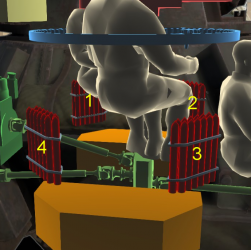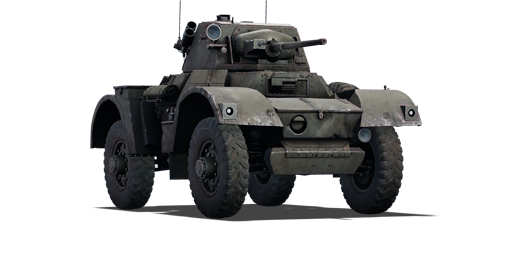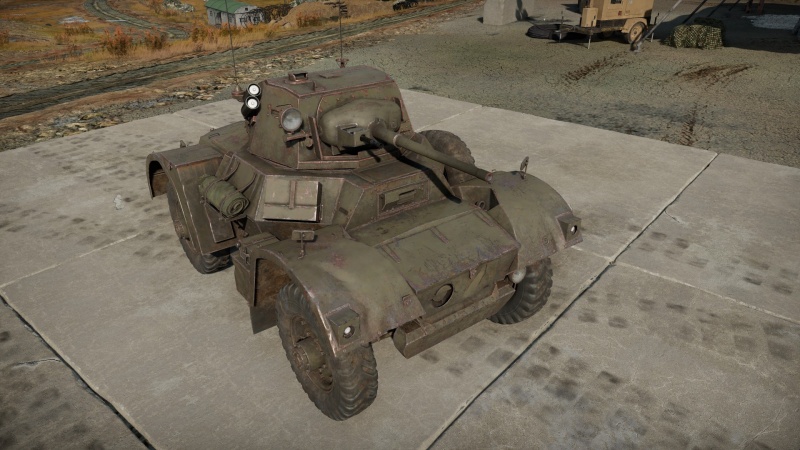Daimler Mk II
Contents
Description
The excellent performance of the turretless Daimler Scout Car led people to suggest that a larger armoured car version with a turret be built as well. The Daimler was similar in design but also introduced a rear-facing wheel for the commander to use in an emergency. The same turret used for the Tetrarch was employed by the Daimler. Most of their use was during the Africa Campaign, where armoured cars were crucial in the vast distances of the dessert, in situations where mobility was often more important than raw power. The tank was Britain's main reconnaissance vehicle during this time period, while it was also the heaviest of all the armoured cars fitted by the British.
It was introduced in Update 1.71 "New E.R.A.". A QF 2-pounder on 4x4 wheels, this vehicle is made to support infantry in a way similar to the cavalry. It is not made to withstand heavy fire. Notably, its wheeled configuration means the car does not fire well when on the move, and it will turn in an arc. Meanwhile, its good reverse speed could possibly save the car as long as the move happens before the enemy shoots. The Daimler is recognisable from other armoured cars by its hexagonal hull centre and its short length. It has 4 mm boxes scattered across the hull and a spare tire on the left side. Besides the main armament, it is equipped with a coaxial BESA machine gun (same MG as higher rank British vehicles), a decent gun to shower open-topped SPGs with lead.
General info
Survivability and armour
Daimler's survivability against enemy impacts is very low. The crew is tightly placed inside the vehicle. The armour plates only provide significant cover against machine guns fire. 20 mm calibre or higher will be able to pierce the armoured car. Having both thin armour and a small crew, the Daimler cannot sustain heavy enemy fire. The Daimler might survive if the enemy shell hits lower the combat compartment, often damaging the transmission but keeping the crew unscathed. The angles of the armour plates offer the possibility of ricocheting some shells, but the chances of this occurring are low.
While the armour is weak, drivers can take advantage of the good manoeuvrability and gun to ambush enemies. The enemies to be most wary of in the Daimler is any vehicle with a rapid firing cannon. German vehicles with 20 mm cannons and most enemy AA vehicles are very dangerous for the Daimler, because their rounds will shred its armour.
Armour type:
- Rolled homogeneous armour
- Cast homogeneous armour (Gun mantlet)
| Armour | Front (Slope angle) | Sides | Rear | Roof |
|---|---|---|---|---|
| Hull | 14 mm (1°) Front plate 14 + 4 mm Front glacis 14 mm (34°) Lower glacis 16 mm (1°) Driver's port |
10 mm (19-34°) Top 10 mm Bottom |
14 mm (1°) Top 14 mm (18-24°) Bottom |
8 mm |
| Turret | 16 mm (16°) Turret front 16 mm (0-79°) Gun mantlet |
14 mm (16-17°) | 10 + 4 mm | 4 mm |
Notes:
- Belly armour is 7 mm thick.
- Wheels provide 2 mm thick armour.
- A 14 mm RHA plate separates the engine compartment from the crew.
Mobility
| Game Mode | Max Speed (km/h) | Weight (tons) | Engine power (horsepower) | Power-to-weight ratio (hp/ton) | |||
|---|---|---|---|---|---|---|---|
| Forward | Reverse | Stock | Upgraded | Stock | Upgraded | ||
| Arcade | Expression error: Unexpected * operator. | 112 | Expression error: Unexpected round operator. | __.__ | |||
| Realistic | 84 | Expression error: Unexpected round operator. | __.__ | ||||
The Daimler is very similar to other British light tanks at the tier, but with one major difference: it has wheels rather than tracks. This difference allows the Daimler to reach really good high speeds on road. Because of this, Daimler drivers should consider planning their route based on what roads are available on the map, however once engaged with the enemy, it is best to find cover rather than remain exposed on the road.
Modifications and economy
Armaments
Main armament
The 40 mm QF (quick-firing) 2-pounder is one of the best guns at the rank, and has a good selection of ammunition. The extremely high rate of fire (2.8s reload) gives the Daimler the ability to dispatch multiple enemies. This means that if the Daimler and the enemy both miss the first shot, the Daimler is likely to get in the second shot before the enemy has reloaded.
The gun penetration is remarkably good even against some rank II vehicles and rank III vehicles' side armour. However, the absence of explosive filler on the highest penetration round (unlike German, Italian, or Swedish counterparts) means the Daimler must fire 2 or more rounds against an enemy tank. Knowing when and where to fire, is vital to exploit the superior reload rate of this cannon. The gun traverse rate is one of the drawbacks to consider. Pretty similar to the previous Tetrarch. The aiming must be aided by smart use of mobility and positioning.
| 40 mm QF 2-pounder | Turret rotation speed (°/s) | Reloading rate (seconds) | |||||||||||
|---|---|---|---|---|---|---|---|---|---|---|---|---|---|
| Mode | Capacity | Vertical | Horizontal | Stabilizer | Stock | Upgraded | Full | Expert | Aced | Stock | Full | Expert | Aced |
| Arcade | 52 | -12°/+25° | ±180° | Vertical | 42.84 | 59.29 | 72.00 | 79.62 | 84.71 | 3.64 | 3.22 | 2.97 | 2.80 |
| Realistic | 9.52 | 11.20 | 13.60 | 15.04 | 16.00 | ||||||||
Ammunition
The most beneficial shell due to the proper ballistics and overall better penetration is the Shot Mk.IXB APCBC/T. The penetration at long-ranges is also superior to all the other shells. Tank commanders are encouraged to use this shell.
The Shot Mk.1 APHV/T (Armour piercing High velocity/ tracer) shell offers a higher muzzle velocity. This will help with the shell drop, but significant penetration is lost with distance.
The Shell Mk.1 AP/T is one of the only shells with armour-piercing and explosive capacities available for the British tanks. It works well during close quarters, but the use at long distances (500+ m) is not advised.
| Penetration statistics | |||||||
|---|---|---|---|---|---|---|---|
| Ammunition | Type of warhead |
Penetration @ 0° Angle of Attack (mm) | |||||
| 10 m | 100 m | 500 m | 1,000 m | 1,500 m | 2,000 m | ||
| Shot Mk.1 AP/T | AP | 72 | 68 | 52 | 37 | 27 | 19 |
| Shot Mk.IXB APCBC/T | APCBC | 89 | 86 | 77 | 66 | 57 | 50 |
| Shot Mk.1 APHV/T | AP | 80 | 75 | 58 | 41 | 30 | 21 |
| Shell Mk.1 AP/T | APHE | 66 | 62 | 49 | 36 | 26 | 20 |
| Shell details | ||||||||||||
|---|---|---|---|---|---|---|---|---|---|---|---|---|
| Ammunition | Type of warhead |
Velocity (m/s) |
Projectile mass (kg) |
Fuse delay (m) |
Fuse sensitivity (mm) |
Explosive mass (TNT equivalent) (g) |
Ricochet | |||||
| 0% | 50% | 100% | ||||||||||
| Shot Mk.1 AP/T | AP | 792 | 1.08 | - | - | - | 47° | 60° | 65° | |||
| Shot Mk.IXB APCBC/T | APCBC | 792 | 1.24 | - | - | - | 48° | 63° | 71° | |||
| Shot Mk.1 APHV/T | AP | 853 | 1.08 | - | - | - | 47° | 60° | 65° | |||
| Shell Mk.1 AP/T | APHE | 792 | 1.08 | 1.2 | 9 | 20.9 | 47° | 60° | 65° | |||
Ammo racks

| Full ammo |
1st rack empty |
2nd rack empty |
3rd rack empty |
4th rack empty |
Visual discrepancy |
|---|---|---|---|---|---|
| 52 | 40 (+12) | 27 (+25) | 14 (+38) | 1 (+51) | No |
Note:
- Shells are modelled individually and disappear after having been shot or loaded.
Optics
| Daimler Mk II Optics | ||
|---|---|---|
| Which ones | Default magnification | Maximum magnification |
| Main Gun optics | x1.85 | x3.5 |
| Comparable optics | AMR.35 ZT3 | |
Machine guns
The machine gun is present as a secondary role gun. The use of this machine gun limits significantly to vehicles with an exposed crew , like anti-air half-tracks or open trucks, Type 94 for example; or SPGs with exposed rear and top like the Panzerjager I.
Commanders should be ready to fire with the machine gun. Because of the quickfire, the machine gun becomes a more effective way to deal with some vehicles. Whereas the main gun might pierce and cause punctual damage, with the machine gun is possible to spray the fire and finish exposed crews quicker.
Another role of this machine gun is for anti-air. The turret traverse speed limits this use but is an available possibility.
| 7.92 mm BESA | ||||
|---|---|---|---|---|
| Mount | Capacity (Belt) | Fire rate | Vertical | Horizontal |
| Coaxial | 675 (225) | 600 | N/A | N/A |
Usage in battles
Generally, the best play style for the Daimler is to flank using a road until near the enemy and then fire from cover against enemy side armour. The Daimler is capable in both short and long-range fights. At long-range make sure to use cover and wait till the enemy looks away before exposing yourself. At close range, you can use your speed to outmanoeuvre the enemy.
Thanks to the good mobility and decent firepower, this light car can be a highly effective flanker. There are also several roles in which the Daimler can effectively perform at:
Brawler
The urban close maps require a high amount of situational awareness. The Daimler's quick-firing gun allows for this playstyle. Nonetheless, the armour doesn't. Commanders should use the mobility both forwards and backwards to wisely position the Daimler. Consider the Daimler is not a tracked vehicle (cannot turn on the spot), so it must turn in what is known as the three-point turn.
Once a good area is found (one that allows the retreat to a second position) The Daimler can remain settled or roam close the zone, along with the allied vehicles. Use hills and slopes to extend the survivability, the cannon is highly flexible due to a good vertical depression. So the Daimler can be close to combat while remaining partially hidden.
The frontal engagements should be fully avoided. Seek alternative routes or stay behind the allied tanks on the frontline.
Supporting light tank
The Daimler is capable to provide quick-fire support to friendly tanks in the frontline. If impossible to penetrate an enemy tank frontally, proceed to fire at the gun's barrel, the tracks or the turret cupola. All of this will help allied tanks.
This is not the only useful aspect of this role, but commanders can become "field mechanics" with these light vehicles and help to repair any allied vehicle in the combat; heavy tanks can use this help greatly because they will be constantly shot and damaged. Be aware of where the fighting is and remain close, a message of allied repair request might appear.
Do not forget to employ the artillery strike to tame enemy's advance in nearby areas or cap zones and release the smoke grenades when needed. All of this can be vital to help the team to win.
| With the Daimler consider never exposing yourself to enemy fire; be ready to retreat in reverse and with smoke cover! |
Pros and cons
Pros:
- Fast forward and reverse speed, and acceleration
- Armour is thin enough to avoid detonating some APHE shells; some shells might pass through
- Decent firepower: fast reload, good penetration and damage, -12° gun depression, stabiliser
- 2 smoke grenade launchers
- Many 4 mm boxes scattered on the hull, offering compact ammo rack protection against shrapnel and machine guns
- Relatively low profile compared to something like M3 Stuart
Cons:
- Armour is lacking overall; only three crewmen means poor survivability
- Wheels does not turn on point; limits mobility
- Has difficulty reaching max speed off-road
- Lacklusture power-to-weight ratio, hinders mobility in rough/uneven terrain
History
The excellent performance of the turretless Daimler Scout Car led people to suggest that a larger armoured car version with a turret be built as well. The Daimler was similar in design but also introduced a rear-facing wheel for the commander to use in an emergency. It carried the same turret as the Tetrarch light tank, putting it on a par with early-war British tanks.
German bombing raids over England hampered production, however, and the vehicle did not enter combat until mid-1942; 2,694 would be built.
In the Desert Campaign, they were used by the King's Dragoon Guards and the Royal Dragoons, and by the time of the Tunisia campaign, additional armoured car regiments. In the desert, the Daimler was normally the heaviest-armed armoured car, with one in each three-car troop. After the North African campaign, armoured car troops were reorganized into 4-car troops with two Daimlers and two lighter armoured scout cars.
Daimlers were also used by the 11th Cavalry in the Burma campaign. They remained in British service until 1960.
Media
- Skins
See also
Vehicles of similar configuration and role:
Vehicles of similar role:
External links
Paste links to sources and external resources, such as:
- topic on the official game forum;
- other literature.
| Daimler Company Limited | |
|---|---|
| Armoured Cars | Daimler Mk II |
| Britain light tanks | |
|---|---|
| A13 | A13 Mk I · A13 Mk I (3rd R.T.R.) · A13 Mk II · A13 Mk II 1939 |
| A15 | Crusader II · Crusader "The Saint" · Crusader III |
| A17 | Tetrarch I |
| IFV | Warrior · Desert Warrior (Kuwait) |
| Wheeled | Daimler Mk II · AEC Mk II · Fox · Vickers Mk.11 |
| Other | VFM5 |
| South Africa | |
| SARC | SARC MkIVa · SARC MkVI (2pdr) · SARC MkVI (6pdr) |
| Ratel | Ratel 90 · Ratel 20 |
| Rooikat | Rooikat Mk.1D · Rooikat 105 · Rooikat MTTD |
| Other | Concept 3 · Eland 90 Mk.7 |
| USA | Stuart I · Stuart III |






